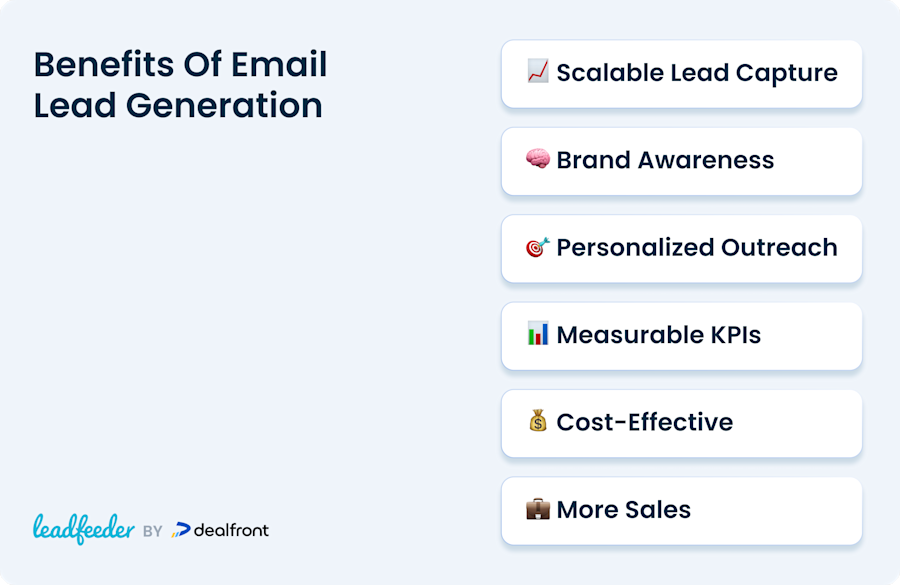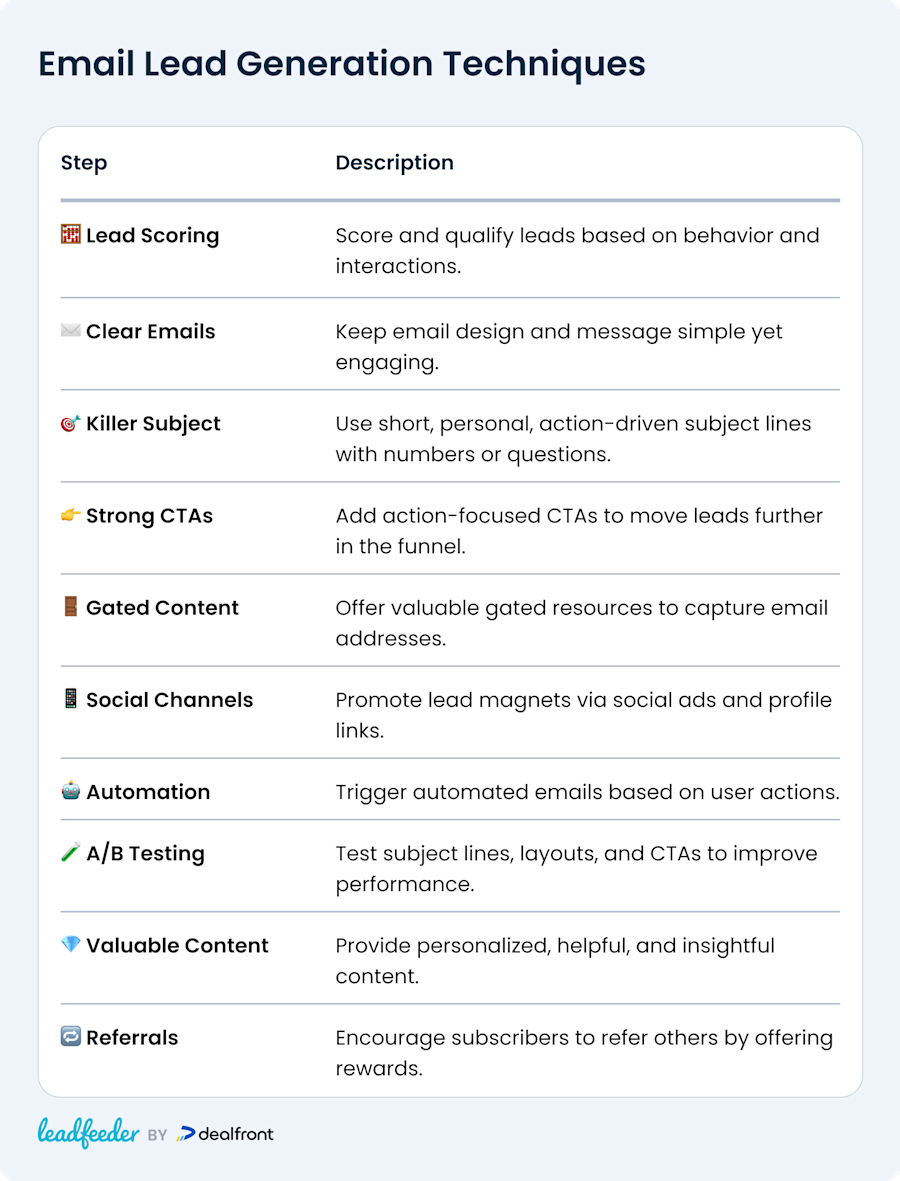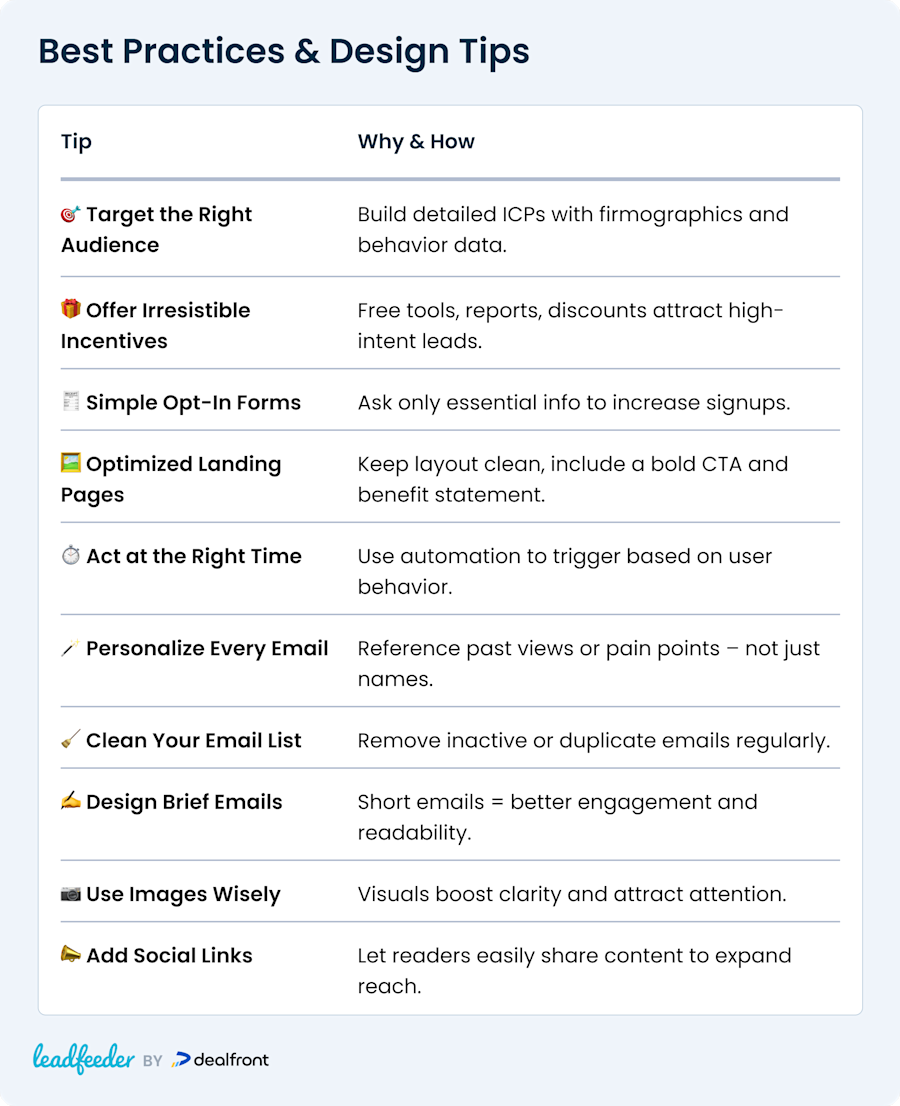Despite being around for decades now, email lead generation still has the power to capture, engage, and convert high-quality leads better than many modern channels—even social media.
In fact, email marketing has an ROI of 312%, outperforming social media, pay-per-click (PPC) ads, and account-based marketing.
That said, you can’t just send any old email to any prospect at any time. You need to target specific audiences, create compelling lead magnets and opt-in forms, and nurture leads with engaging, optimized email content.
So, let’s explore 10 powerful email lead generation tactics along with a few best practices, email templates, and design tips. Plus, we’ll discuss how you can use lead generation tools like Leadfeeder to leverage email to its full potential.
Ready to identify and contact anonymous website visitors? Start your free trial of Leadfeeder today.
What are email leads?
An email lead is a prospective customer who has given you their email address.
Typically, prospects will fill out an opt-in form on your website and exchange their contact details for a lead magnet. A lead magnet is something valuable that you offer your prospect to incentivize them to hand over their email address, such as an exclusive discount, gated content, or a free tool.
This turns the prospect into an email lead, where you can communicate with them to nurture relationships and drive conversions.
What is email lead generation?
Email lead generation describes the marketing strategies used to acquire new email leads.
For example, you might use lead capture forms—also known as opt-in forms—to collect customer information, such as names and email addresses. You might also use a website tracking tool to identify customers who are already visiting your website and reach out to them directly to convert them into an email lead.
But it doesn’t end there. Email lead generation also involves creating email marketing strategies that encourage leads to stick around and, ultimately, convert into paying customers.
Why having a lead generation strategy is important
Lead generation is the constant driving force behind business growth. But high-quality leads don’t just appear out of thin air—they need to be identified, targeted, and nurtured to conversion. This is especially true for B2B leads, who are more elusive and require hyper-targeted strategies.
Lead generation strategies introduce your brand to lots of potential prospects, populating the top of your marketing funnel with new leads.
But, even more crucially, they ensure that you’re pulling in the right leads—leads that align with your target audience, possess a need for your product, and have a high intent to purchase.
Plus, 30% of B2B sales cycles take between one and three months. For around 25%, it’s even longer than that. The faster you capture these leads, the faster you can target them with engaging content to drown out noise from your competitors.
Benefits of email lead generation
Let’s take a look at the main advantages of using email marketing for lead generation.

1) High-quality lead capture at scale
Opt-in forms and lead magnets can be shown to every prospect who visits your website. As long as you’re targeting the right audience with a valuable lead magnet, this can generate a steady stream of high-value leads.
2) Increased brand awareness and interest
You can regularly update leads about your latest products, offers, and content via email. This keeps your brand top-of-mind to boost awareness and retain interest.
3) Personalized communications
Email marketing tools let you segment audiences based on their industry, location, company size, etc. So, you can tailor email campaigns to deliver relevant content to customers and maximize engagement.
4) Measurable results
Access key email marketing KPIs like open rates, click-throughs, conversions, and subscriber retention rates to track, analyze, and optimize email campaign performance.
5) Cost-effectiveness
Email lead generation is a low-cost strategy compared to traditional and paid methods, allowing businesses on a budget to generate leads.
6) More conversions and sales
Email leads have already shown an interest in your product or services, which makes them easier to convert. By targeting email leads with value-rich content, you can nurture them down the funnel and cinch more conversions.
10 best email lead generation techniques for 2025
Want to get started with email lead generation? Here are 10 tried-and-tested techniques that you can use today.

1) Lead scoring
Lead scoring helps you quickly identify and target email leads that have high conversion potential.
Let’s say that a prospect subscribes to your email list. Using lead generation software, you can score and qualify the lead based on specific actions or behaviors, such as opening your email, clicking on your CTA, downloading your ebook, or signing up for your webinar.
The higher the score, the more likely the customer is to convert. So, you can target the right prospect at the right time with the right type of message—no more wasting resources and productivity on leads that are unlikely to convert.
2) Clear and concise emails
Engaging emails have simple designs and clear, concise messages that hold your reader’s attention and facilitate easy decision-making.
Avoid unnecessary information, technical jargon, or over-elaborate designs, as they can overwhelm readers, cause misunderstandings, and frustrate customers enough for them to bounce or unsubscribe.
This doesn’t mean your emails have to be boring. Feel free to inject your brand’s personality into your email content—just make sure that your core message shines through.
3) Attention-grabbing subject lines
It doesn’t matter what you write in your emails if you can’t get prospects to open them in the first place.
Your subject lines need to stand out from the sea of marketing emails flooding your prospect’s inbox and entice them to open your message. So, it’s time to get creative (while also keeping best practices in mind).
Here are a few tips to help you create compelling, click-worthy subject lines:
Keep it short: Emails with shorter subject lines have higher click-through rates, so try to keep your subject lines within nine words. You could even try out a one-word subject line. According to data from Klenty, they have an impressive open rate of almost 35%.
Include your prospect’s name: Add a personalized touch by addressing your customer by their first name. Klenty found that this skyrocketed open rates from 10% to 39%. Including other personalized details, such as the prospect’s company or location, can also grab attention.
Use action-oriented verbs: Inspire customers to take action by using words such as “attend,” “discover,” or “update” at the beginning of your subject line. This sparks curiosity and urgency, two key ingredients for click-worthy subject lines.
Add data and numbers: When prospects are scanning through their inbox, a number or intriguing statistic can catch their eye. For example: “Join 10,000 Customers” or “Grow Your Engagement Rates by 75%”.
Ask a question: Pose a relevant, burning question to pique your audience’s interest. For example, the subject line “What do your customers really think?” prompts leads to open the email to see the answer.
4) Clear and compelling call-to-action
So, your prospect has read your email—now it’s time for them to move further down the sales funnel. This involves luring them from the email to your content with a strong call to action (CTA).
CTAs should be snappy, compelling, and action-driven. They compel the reader to take the next step, whether that be to engage with your website content or check out your product demo. Use action words like “read,” “download,” “sign up,” “try,” and “join” to motivate prospects to take immediate action.
5) Content upgrades and gated resources
Gated resources and content upgrades are lead magnets that can only be accessed by prospects once they’ve signed up for your email list. They can include anything from reports, ebooks, and whitepapers to exclusive webinars and free tools.
If a prospect reads your blog post, you might show them a pop-up lead capture form that promotes your webinar on the same subject. Or if they’re reading a summary of your report, you might promote the full report as a content upgrade.
Offering relevant, valuable, and actionable resources incentivizes prospects to give you their email address, which allows you to target them with email marketing communications.
6) Social media platforms
Why not turn social media users into email leads by advertising your lead magnets on platforms like LinkedIn, Facebook, or Pinterest?
Gain a presence on social media and add a lead magnet CTA to your profile and social media ads. Create engaging, shareable posts that communicate the benefits of subscribing to your email list. Ensure they have CTAs, too.
Use social media marketing tools to track key metrics, such as likes, shares, and conversions, to see which strategies successfully generate email leads.
7) Email automation
Email automation enhances efficiency by enabling you to send bulk emails and drip email campaigns that trigger when prospects complete certain actions.
For example, you might create email campaigns that trigger when a customer:
Joins your email list
Downloads your resource
Signs up for or attends your webinar
Engages with specific product pages
These emails can be scheduled and sent in bulk to deliver consistent, personalized communications to customers without hindering your team’s productivity.
8) A/B testing
A/B testing involves presenting two versions of your email to two groups of your target audience to see which version performs better.
You can A/B test almost every element of your email, such as the subject line, font, body text, CTAs, and email layout. It tells you which email elements your leads prefer so you can optimize them for increased open rates, click-throughs, and conversions.
Discover which subject lines generate the most opens, which visuals and layouts resonate with audiences, which CTAs drive more conversions, and much more.
9) Informative and valuable content
If your sales funnel were a river, your content would be the currents guiding customers along it. So, it’s paramount that every piece of content you share via email delivers real value to your audience.
This is especially true for email lead generation B2B, where prospects rely on your content to learn more about your product and how it can help them solve their pain points and meet their goals.
They also expect you to be a thought leader in your field, which you can demonstrate by providing informational, personalized content like:
Blog posts
Thought-leadership articles
How-to videos and guides
Case studies
Whitepapers
Customer testimonials
Webinars and podcasts
Research reports
Aim to understand your prospects’ unique needs at every stage of the funnel and deliver content that’s relevant, informative, and motivational.
10) Referrals from existing subscribers
This savvy email lead generation technique enlists the help of your existing subscribers to generate new email leads.
Incentivize current subscribers to refer your email list to their friends, family, and professional network by offering them a reward for every successful referral they make.
The reward could be anything you like—a discount, freebie, charity donation, or product/service upgrade, for example. The only requirement is that it has to be something worthwhile to encourage subscribers to participate.
Email lead generation best practices
While you’re implementing the email lead generation tactics above, try to follow these key best practices to maximize success.

1) Reach the right audience
To populate your email list with lots of high-quality leads, you need to make sure you’re targeting the right customers.
Start by creating ideal customer profiles (ICPs) that reflect the characteristics of prospects who are most likely to convert. Collect key firmographics like their company size, industry, location, sales cycle process, and revenue, along with pain points, goals, and budget.
From there, develop detailed ICPs and formulate the best strategies for targeting them. Reach out on the platforms they use and create content that resonates with their needs and goals.
2) Develop an irresistible opt-in incentive
Standard blog posts and articles don’t make great opt-in incentives, as prospects can get those anywhere for free. Entice prospects with a lead magnet that’s truly compelling by using customer data to unmask what resources your prospects will find most beneficial.
The best opt-in incentives include free trials and product demos, templates, research reports, case studies, discounts, and free tools.
3) Design a straightforward opt-in form
Signing up for your email list should be effortless.
Design a simple opt-in form that’s free of clutter and concisely communicates the benefits of joining. Don’t ask for unnecessary details—customers may find it intrusive and be put off by the length, which can reduce conversions.
A good rule of thumb is to ask for their name, email addresses, and (if relevant) another detail like their industry or job title.
4) Refine and optimize your landing page
Email lead generation landing pages are dedicated pages on your website with a single focus: to convince prospects to sign up for your email list.
To optimize your landing page for conversions, you should:
Use a clean, simple layout and an attractive design with high-quality visuals.
Capture interest with a compelling headline.
Clearly define the value of your offering, focusing specifically on your lead magnets and/or the benefits of signing up.
Optimize your page for different devices to ensure that the page loads quickly and correctly.
Add a short, simple opt-in form.
Include a strong, action-oriented CTA that stands out on the page.
5) Act at the right moment
Try to convert prospects too early, and you risk frustrating them. But if you leave it too late, the prospect might bounce. So, you need to act at the right moment, which can be achieved using marketing automation.
For example, if a customer lands on your blog article and scrolls to the end, you might show them a pop-up that invites them to sign up for your email list for additional content and benefits.
Or, you might set up email campaigns that trigger after a customer takes a specific action. If they download your ebook, email the prospect to suggest similar content they might enjoy.
Alternatively, if they sign up for your free trial, send an automated message after a week that promotes your full product.
Even better, you don’t actually need a prospect to take a specific action to be able to reach out at the right time. With Leadfeeder’s help, you can engage with open opportunities visiting your website, which you might otherwise have not even known about.
Don’t forget to analyze open rates at different times and days of the week to identify the best time to send emails. 47.9% of B2B marketers say that their peak email engagement times are between 9am and 12pm.
6) Tailor your emails to each recipient
B2B and B2C customers both view personalization as essential to their buying journey. Using what you know about each customer—their firmographics, content preferences, pain points, etc.—segment your list and tailor your emails to every recipient’s needs and interests.
This goes beyond including their name in your subject line. Personalize emails by referring to the content they’ve recently viewed or a pain point you know they have. This helps you keep prospects engaged and build authentic relationships.
7) Regularly prune and update your email list
Inactive, disengaged email addresses can hurt your sender reputation. And they harm the effectiveness of your email campaigns, open rates, and engagement rates.
Regularly clean and update your email list to keep it healthy and primed for effective campaigns. Identify unsubscribed, inactive, invalid, and duplicated email addresses and remove them from your list.
Before removing disengaged subscribers, you could try targeting them with a re-engagement campaign. This can reignite their interest and pull them back into the funnel. But if they remain inactive, it’s best to let them go.
How to design an email for lead generation
Now, let’s walk through a few quick design tips for your lead generation emails.
Subject lines
Your subject line needs to be compelling to entice leads to open the email. So, aim to create subject lines that are personalized, intriguing, actionable, and promise value.
Brevity
Brief emails are optimal for engagement and conversions because they’re easy to read and comprehend. So, try to keep the length of your emails short and sweet.
Imagery
Images help you keep your emails brief. They act as visual aids for your readers, enabling them to quickly comprehend your message without needing to read through lots of text. Plus, they’re excellent at capturing attention.
Social integration
Why not add social media sharing links to your email? They encourage leads to share your content on their own social platforms, boosting your reach and reeling in new leads.
Call-to-action
Every email should have a powerful CTA that tells leads exactly what to do next, e.g., “Download your free ebook” or “Attend our webinar.” Make sure the CTA stands out from the page by using a unique button design, bold font, or contrasting color.
Email lead generation examples
To build your email list, you need to offer prospects something that they just can’t say “no” to. Let’s look at a few examples:
Free resource download: Entice customers with free resources like reports, whitepapers, and templates.
Webinar invitation: Invite prospects to attend an exclusive webinar that relates to their business needs and goals in exchange for their email address. Clearly communicate the value of your webinar to get more sign-ups.
Limited-time offer or discount: Discounts are irresistible for prospects on a budget. For example, you could offer 20% off future purchases if they opt in for your email list. Create a sense of urgency by setting a time limit to urge leads to take action.
Free trial or demo offer: Free trials and demos allow leads to try out your product for a limited time. They’re the ultimate lead magnet because they let prospects discover the value of your product for themselves—a tempting offer that can lead to purchases.
Case study or success story: Your B2B customers will be using case studies, testimonials, and success stories to evaluate your product. So, use them as lead magnets or promote them within your lead generation emails to move customers along your sales funnel.
Five best email lead generation templates
We’ve compiled five customizable email templates that you can use in your lead generation campaigns. Whether you’re conducting sales outreach or nurturing new leads further down the funnel, these templates can be adjusted for all situations.
Free ebook download template
Hi [Name],
We saw you checking out our blog post on [topic] and thought you’d be interested in our free ebook! It goes into more detail about practical strategies that you can use to improve [skill/metric].
Download your free copy now.
Webinar invitation template
Hi [Name],
We’re delighted to offer you an exclusive invitation to our live webinar on May 17th! You’ll join renowned industry expert [Name] to discuss [topic] and get the answers to all your burning questions.
Register for our webinar now to secure your spot.
Limited-time offer template
Hi [Name],
Are you looking to upgrade your [software]? We’re offering 25% off all our products until May 25th—and we don’t want you to miss out on [improving specific business goal] for less! So, explore our range of software plans and select the right one for you before time runs out.
Get 25% off today.
Free trial template
Hey [Name],
Are you itching to try out a cutting-edge solution with [standout product feature]? Now you can—for free. Sign up for a 14-day free trial of [your product], where you get access to [specific features] that will transform your business operations.
Sign up for your free trial here.
Case study template
Hi [Name],
Are you struggling with [pain point]? So were [relevant company] until they switched to [your solution]. After six months, they increased their [metric] by [%] and catapulted their ROI—all while improving their productivity.
If you want to learn more, here’s a case study that goes into depth about how [previously named company] went above and beyond their goals with the help of [your solution].
Read the case study here.
Use the best tool for email lead generation
Opt-in forms are an irreplaceable email lead generation tactic—but they don’t always produce high-value leads. A B2B lead generation tool like Leadfeeder can give you access to the email addresses of anonymous website visitors (along with company names, job titles, and more).
How does this help you? It enables you to reach out to interested prospects at the top of the funnel with personalized emails to expedite conversions—all without asking prospects to fill out a form.
With Leadfeeder’s custom segmentation, you can qualify prospects against 50+ behavioral and firmographic filters, such as which product pages they visit and what content they download. Accurately gauge their pain points, needs, and buying intent to tailor email campaigns and reach out with the right message at the right time.
Want to learn more about how Leadfeeder can power your email lead generation campaigns? Reach out to our team or request a demo today.
Email lead generation FAQs
What are lead generation emails?
Lead generation emails are marketing emails that you send to potential customers to entice them to take a specific action (e.g., to download your ebook, attend your webinar, or try out your product demo). The goal is to turn the prospect into a qualified lead.
What should be included in an email for lead generation?
Your lead generation emails should include a clear, core message—one that offers value and incites a prospect to take action. Optimizing the email for conversion also involves using an attention-grabbing subject line, a compelling headline, a clean design, and a strong CTA.
How often should I follow up on my emails?
If you send too many emails, you risk spamming your prospects, but if you don’t send enough, your leads might get distracted by your competitors. Although it always depends on customer preferences, you should aim to engage with leads one or two times a week to keep your brand top-of-mind and maintain engagement without overwhelming prospects.
How to generate email marketing leads
Creating content that drives your target audience to your website is the most reliable way to generate email marketing leads. Once they’ve engaged with your website content, target them with a lead capture form to obtain their email address.
What metrics should I track in my email campaigns?
Focus on engagement metrics like open rates, click-through rates, and conversions. Other metrics to track include bounce rates, unsubscribe rates, and email list growth rates.
How do I get an email address for lead generation?
You can use opt-in forms to get email addresses. This tactic requires you to offer something valuable in exchange, such as a free resource. You can also obtain the email addresses of prospects who visit your website using website identification tools like Leadfeeder.
How much is an email lead worth?
Email marketing can provide an ROI as high as $44 for every $1 spent, suggesting that email leads are worth their weight.
That said, the true value of your email leads depends on other factors, such as whether they go on to make a purchase, refer your product, or share your content. Analyze metrics like conversion rates, customer lifetime values, and cost per lead.
Is it legal to buy email lists?
Yes—it’s legal to buy email lists as long as you follow the rules of your jurisdiction. But proceed with caution. There’s no guarantee that the email addresses you’re buying are valid.
And even if they are, there’s a high chance you’ll get reported as spam when you send emails to unsuspecting addresses. So, it’s recommended that you avoid purchasing email lists at all costs.
Now that you're here
Leadfeeder is a tool that shows you companies that visit your website. Leadfeeder generates new leads, offers insight on your customers and can help you increase your marketing ROI.
If you liked this blog post, you'll probably love Leadfeeder, too.
Sign up




